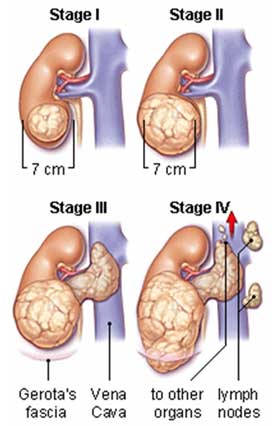Health Tools
Hygiene
Naturopathy
Mental health
More Articles
Stages of Kidney Cancer
What is Kidney Cancer
The kidneys are paired organs in the abdomen of the human body.
They filter the blood to remove toxins, waste chemicals and water. This filtered fluid is then concentrated to
form urine. From the kidneys, the urine passes out into the ureters (connecting pipes) to be stored in the bladder.
The kidneys also produce a hormone that stimulates the bone marrow to produce red blood cells. Other hormones
are produced and act on the kidneys to regulate how much water is retained by the body.
Kidney cancer, also known as renal cell carcinoma, occurs because of abnormal cells in the kidney's filtering
system. Renal cell carcinomas often start as small tumours. They may be few symptoms. About one quarter of RCCs
will have spread to other organs by the time they are recognized. The most common sites for renal cancers to
spread are the lungs, bones and lymph nodes near the kidneys.
the time someone is diagnosed with kidney cancer, the specialist will determine the "stage" of their disease.
There are four stages. Depending on the stage of the disease (ie how big the tumour is, or whether it has spread),
the best decision about treatment and the likely outcomes can be discussed.
Stage 1:
the cancer is confined to only one kidney and is not more than 7cm. These
patients have the best long-term survival and are most likely to be cured with surgery. The five year survival
rate is almost 90%.
Stage 2:
the cancer is more than 7cm, but does not extends outside the surrounding layer of the kidney (known as the capsule).
These patients also have a high rate of survival and surgery is a good treatment option. The five year survival
rate is more than 75%.

Stage 3:
the cancer may be of any size, but it extends outside the capsule of the kidney and into blood vessels. In these
patients, the specialist will give advice about appropriate treatment. These patients have a 5 year survival rate
of close to 65%.
Stage 4:
: the cancer of the kidney in these patients may be of any size. However these patients have the lowest rate of
long-term survival because the tumour has spread outside the kidney to other organs. Less than 10% of these patients
survive 5 years
Who gets Kidney Cancer?
Primary kidney cancer (renal cell carcinoma) is relatively uncommon. More commonly people may be found to
have cancer of the kidney because it has spread there from another organ in the body. However renal cell
carcinoma still makes up around 2% of all cancers. It occurs more commonly amongst men than women.
In Australia, there are just over 2000 new cases of primary kidney cancer diagnosed each year. Primary
kidney cancer is mostly a disease seen in adults over 40. The average age of people found to have renal cell
carcinoma is 55 years. International and Australian research suggests that the rate of renal carcinomas is
increasing at about 2% per year. The reasons for this increase are not known
Renal cancer can be classified into several different types based on the appearance of the cancer cells
under a microscope (this is called the microscopic appearance or microscopy). There are three main subtypes:
Classification:
Clear cell carcinoma
Papillary cell carcinoma
Chromophobe carcinoma